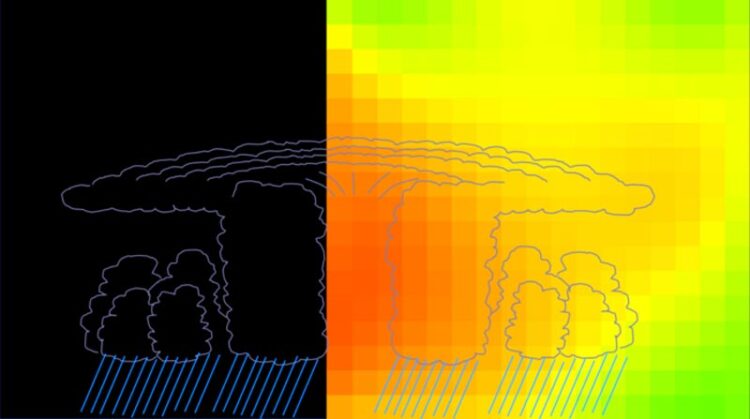Opening the eye of the storm

The redder areas are low-pressure warm air, and the green areas are higher-pressure cooler air. The cyclone in this image is about 15 kilometers tall. A line drawing approximating the shape overlays the visualization data.
Credit: ©2022 Hiroyuki KM Tanaka
Cosmic rays used to track and visualize tropical cyclones offer new perspectives.
For the first time, high-energy muon particles created in the atmosphere have allowed researchers to explore the structures of storms in a way that traditional visualization techniques, such as satellite imaging, cannot. The detail offered by this new technique could aid researchers modeling storms and related weather effects. This could also lead to more accurate early warning systems.
It’s hard not to notice the number of stories in the news about heavy storms in different parts of the world, often attributed to climate change. Weather prediction and early warning systems have always been important, but with increased storm activity it seems especially so these days. A team of researchers, led by Professor Hiroyuki Tanaka from Muographix at the University of Tokyo, offer the world of meteorology a novel way of detecting and exploring tropical cyclones using a quirk of particle physics that takes place above our heads all the time.
“You’ve probably seen photographs of cyclones taken from above, showing swirling vortices of clouds. But I doubt you’ve ever seen a cyclone from the side, perhaps as a computer graphic, but never as actual captured sensor data,” said Tanaka. “What we offer the world is the ability to do just this, visualize large-scale weather phenomena like cyclones from a 3D perspective, and in real time too. We do this using a technique called muography, which you can think of like an X-ray, but for seeing inside truly enormous things.”
Muography creates X-ray-like images of large objects, including volcanoes, the pyramids, bodies of water, and now, for the first time, atmospheric weather systems. Special sensors called scintillators are joined together to make a grid, a little like the pixels on your smartphone’s camera sensor. However, these scintillators don’t see optical light, but instead see particles called muons which are created in the atmosphere when cosmic rays from deep space collide with the atoms in the air. Muons are special because they pass through matter easily without scattering as much as other types of particles. But the small amount they do deviate by as they pass through solid, liquid, or even gaseous matter, can reveal details of their journey between the atmosphere and the sensors. By capturing a large number of muons passing through something, an image of it can be reconstructed.
“We successfully imaged the vertical profile of a cyclone, and this revealed density variations essential to understanding how cyclones work,” said Tanaka. “The images show cross sections of the cyclone which passed through Kagoshima Prefecture in western Japan. I was surprised to see clearly it had a low-density warm core that contrasted dramatically with the high-pressure cold exterior. There is absolutely no way to capture such data with traditional pressure sensors and photography.”
The detector the researchers used has a viewing angle of 90 degrees, but Tanaka envisages combining similar sensors to create hemispherical and therefore omnidirectional observation stations which could be placed along the length of a coastline. These could potentially see cyclones as far away as 300 kilometers. Although satellites already track these storms, the extra detail offered by muography could improve predictions about approaching storms.
“One of the next steps for us now will be to refine this technique in order to detect and visualize storms at different scales,” said Tanaka. “This could mean better modeling and prediction not only for larger storm systems, but more local weather conditions as well.”
Journal article: Hiroyuki K.M. Tanaka, Jon Gluyas, Marko Holma, Jari Joutsenvaara, Pasi Kuusiniemi, Giovanni Leone, Domenico Lo Presti, Jun Matsushima, László Oláh, Sara Steigerwald, Lee F. Thompson, Ilya Usoskin, Stepan Poluianov, Dezső Varga, Yusuke Yokota. “Atmospheric Muography for Imaging and Monitoring Tropic Cyclones”. Scientific Reports.
Research contact:
Professor Hiroyuki Tanaka
Muographix, The University of Tokyo,
1-1-1 Yayoi, Bunkyo-ku, Tokyo 113-0032, Japan
email: ht@muographix.u-tokyo.ac.jp
Muographix – https://www.muographix.u-tokyo.ac.jp/
Press contact:
Mr Rohan Mehra
Public Relations Group, The University of Tokyo
7-3-1 Hongo, Bunkyo-ku, Tokyo 113-8656, Japan
email: press-releases.adm@gs.mail.u-tokyo.ac.jp
About The University of Tokyo
The University of Tokyo is Japan’s leading university and one of the world’s top research universities. The vast research output of some 6,000 researchers is published in the world’s top journals across the arts and sciences. Our vibrant student body of around 15,000 undergraduate and 15,000 graduate students includes over 4,000 international students. Find out more at www.u-tokyo.ac.jp/en/ or follow us on Twitter at @UTokyo_News_en.
Journal: Scientific Reports
DOI: 10.1038/s41598-022-20039-4
Method of Research: Experimental study
Subject of Research: Not applicable
Article Title: Atmospheric muography for imaging and monitoring tropical cyclones
Article Publication Date: 6-Oct-2022
All latest news from the category: Power and Electrical Engineering
This topic covers issues related to energy generation, conversion, transportation and consumption and how the industry is addressing the challenge of energy efficiency in general.
innovations-report provides in-depth and informative reports and articles on subjects ranging from wind energy, fuel cell technology, solar energy, geothermal energy, petroleum, gas, nuclear engineering, alternative energy and energy efficiency to fusion, hydrogen and superconductor technologies.
Newest articles

Innovative 3D printed scaffolds offer new hope for bone healing
Researchers at the Institute for Bioengineering of Catalonia have developed novel 3D printed PLA-CaP scaffolds that promote blood vessel formation, ensuring better healing and regeneration of bone tissue. Bone is…

The surprising role of gut infection in Alzheimer’s disease
ASU- and Banner Alzheimer’s Institute-led study implicates link between a common virus and the disease, which travels from the gut to the brain and may be a target for antiviral…

Molecular gardening: New enzymes discovered for protein modification pruning
How deubiquitinases USP53 and USP54 cleave long polyubiquitin chains and how the former is linked to liver disease in children. Deubiquitinases (DUBs) are enzymes used by cells to trim protein…



